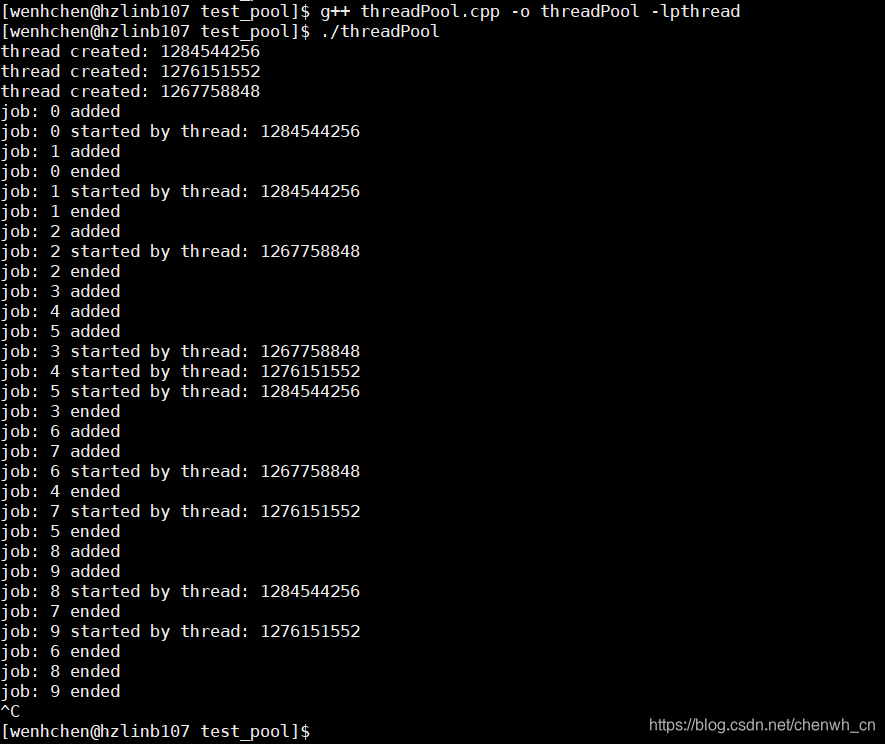1. 线程池原理
在传统服务器结构中,常用一个总的监听线程监听新用户连接,当有一个新用户进入时,服务器就开启一个新的线程,用于处理这个用户的数据收发,这个线程只服务于这个用户,当用户与服务器端连接关闭以后,服务器将销毁这个线程
然而频繁地开辟与销毁线程会极大地占用系统资源,线程池的基本思想是提前创建好一些线程,有新任务到来时,则在线程队列中找到一个空闲线程来处理,处理完后线程不退出重回空闲状态继续等待新任务。如果没有空闲线程,则将任务存放到队列, 等待线程池内有线程空闲以后再从任务队列取出任务进行处理。这样就避免了线程创建和销毁的系统资源开销
线程池应用场景:一个应用要频繁的创建和销毁线程,但任务执行的时间又非常短,这样线程创建和销毁的系统资源开销就不容忽视,这时就可以使用线程池了
2. 实现分析
线程池包含四个部分:
i. 线程队列,存储创建的多个线程
ii. 任务队列,存储需要处理的任务,使用 list 链表实现,当有新任务到来时,将节点插入到 list 尾部,当空闲线程读取任务进行处理时,则读取 list 头部节点
iii. 信号量 sem,指示任务队列中的任务个数,当有新任务加入时,执行 sem_post 操作+1,空闲线程通过 sem_wait 等待任务队列变成非空状态
iv. 互斥量 mutex, 用于执行添加/移除 list 节点时,进行多线程保护
a. 创建并开始多个线程,线程执行函数是个 while 循环,循环等待任务队列不为空,一旦不为空,则读取 list 头节点,获取任务执行方法和参数,然后执行任务,完成后释放头结点空间
b. 添加新任务到队列,申请新任务节点空间,用于存储新任务执行方法和参数,然后将新任务节点插入到 list 的尾部
3. 代码实现
#include <stdio.h>
#include <stdlib.h>
#include <unistd.h>
#include <semaphore.h>
#include <pthread.h>
#define MAXNUM_THREAD 3
#define MAXNUM_JOB 10
typedef void* (*Func)(void *arg);
struct job {
Func func;
void *arg;
struct job *next;
};
struct pool {
pthread_t threads[MAXNUM_THREAD];
struct job *head;
pthread_mutex_t mutex; // used for add/remove list node action
sem_t sem; // indicate threads can get one job node from list
};
void* threadFunc(void* arg)
{
Func jobFunc;
void *jobArg;
struct job *head;
struct pool *pl = (struct pool*)arg;
while (1)
{
sem_wait(&(pl->sem)); // wait new job node added to list
pthread_mutex_lock(&(pl->mutex)); // wait other threads complete list action
head = pl->head;
pl->head = pl->head->next; // unlink head node from list, free after func done
pthread_mutex_unlock(&(pl->mutex));
jobFunc = head->func;
jobArg = head->arg;
jobFunc(jobArg);
free(head); // free unlinked head node
}
}
void poolInit(struct pool *pl)
{
pl->head = NULL;
pthread_mutex_init(&(pl->mutex), NULL);
sem_init(&(pl->sem), 0, 0);
for (int i=0; i<MAXNUM_THREAD; i++)
{
pthread_create(&(pl->threads[i]), NULL, threadFunc, (void *)pl);
printf("thread created: %u\n", (unsigned int)(pl->threads[i]));
}
}
void addJob(struct pool *pl, Func func, void *arg)
{
struct job* jobNode = (struct job*)malloc(sizeof(struct job));
jobNode->func = func;
jobNode->arg = arg;
jobNode->next = NULL;
pthread_mutex_lock(&(pl->mutex));
if (NULL == pl->head) // add job node to list tail
{
pl->head = jobNode;
}
else
{
struct job *head = pl->head;
while (head->next)
{
head = head->next;
}
head->next = jobNode;
}
pthread_mutex_unlock(&(pl->mutex));
sem_post(&(pl->sem)); // threads can get job node from list
}
void* jobFunc(void* arg)
{
int index = *((int*)arg);
printf("job: %d started by thread: %u\n", index, (unsigned int)pthread_self());
sleep(rand()%5);
printf("job: %d ended\n", index);
}
int main()
{
int i = 0;
int jobIds[MAXNUM_JOB] = {0};
struct pool pl;
poolInit(&pl);
for (i=0; i<MAXNUM_JOB; i++)
{
jobIds[i] = i;
printf("job: %d added\n", i);
addJob(&pl, jobFunc, (void*)&jobIds[i]); // add job node to list
sleep(rand()%2);
}
for (i=0; i<MAXNUM_THREAD; i++)
{
pthread_join(pl.threads[i], NULL);
}
pthread_mutex_destroy(&(pl.mutex));
sem_destroy(&(pl.sem));
return 0;
}
运行结果如下:









 本文深入探讨线程池的工作原理,分析其如何通过预创建线程减少资源开销,并详细解析线程池的四大部分:线程队列、任务队列、信号量和互斥量。同时,提供了一个具体的线程池代码实现案例。
本文深入探讨线程池的工作原理,分析其如何通过预创建线程减少资源开销,并详细解析线程池的四大部分:线程队列、任务队列、信号量和互斥量。同时,提供了一个具体的线程池代码实现案例。
















 509
509

 被折叠的 条评论
为什么被折叠?
被折叠的 条评论
为什么被折叠?








